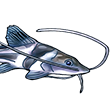I have kept cories for many years with good success and have had the occasional common plec in my bigger tanks but I recently got 3 juvenile bristlenose plecs at a club auction. I am at least aware enough to know that only the males get the bristly nose look to them but I don't have a clue how to look after these guys or even which ones they are. They are juveniles so even the bristly nose is not yet apparent on them. When I first looked closely at them in my tank, I thought there was a fungus or something on their backs because it was a slightly lighter color than the rest of their body but now I realize it is a consistent color difference on that part of all 3 of them. I would say it reminds me of a saddle of lighter color than the rest of the body.Is there a place that I can look to try to identify them or do I just page through all of the L pictures looking for a decent match to mine?
PS: The tank water conditions in all of my tanks are slightly basic pH with a hardness between 10 and 15 german degrees. I have tried feeding them some lettuce but they ignored it. The spirulina sticks disappear in their tank but with all of the mollies in the tank I would expect that even without the bristlies. I do have some well seasoned driftwood in their tank because I have read that they need it as part of their diet. They spend lots of time there so I hope that was a good move.
New to BNPs
- OldMan
- Posts: 112
- Joined: 08 Mar 2008, 16:45
- I've donated: $20.00!
- My cats species list: 8 (i:0, k:0)
- My aquaria list: 9 (i:0)
- Location 2: Forsyth, IL, USA
- Interests: Tropical fish, carpentry, photography
- MatsP
- Posts: 21038
- Joined: 06 Oct 2004, 13:58
- My articles: 4
- My images: 28
- My cats species list: 117 (i:33, k:0)
- My aquaria list: 10 (i:8)
- My BLogs: 4 (i:0, p:164)
- Spotted: 187
- Location 1: North of Cambridge
- Location 2: England.
Re: New to BNPs
is a list of all species of "bristlenoses". I'd hazzard a guess that they are .
Having a saddle or some such is usually an indication of "stress colouration", but without a photo, I can't say for sure.
Read my feeding article linked on the right of this post (where it says "Articles(1)"). They are mainly vegetarian, but will eat many other things given half a chance.
Edit: As for care - couldn't be easier. Keep them wet enough, give them some food, and a few places to hide, and they will do well. If you have a male and a female, give them some extra meaty food now and again, and a cool water-change, and you are likely to get some fry soon. [Obviously, you need to grow them out to about 2-2.5" for them to be mature enoug].
--
Mats
Having a saddle or some such is usually an indication of "stress colouration", but without a photo, I can't say for sure.
Read my feeding article linked on the right of this post (where it says "Articles(1)"). They are mainly vegetarian, but will eat many other things given half a chance.
Edit: As for care - couldn't be easier. Keep them wet enough, give them some food, and a few places to hide, and they will do well. If you have a male and a female, give them some extra meaty food now and again, and a cool water-change, and you are likely to get some fry soon. [Obviously, you need to grow them out to about 2-2.5" for them to be mature enoug].
--
Mats
- OldMan
- Posts: 112
- Joined: 08 Mar 2008, 16:45
- I've donated: $20.00!
- My cats species list: 8 (i:0, k:0)
- My aquaria list: 9 (i:0)
- Location 2: Forsyth, IL, USA
- Interests: Tropical fish, carpentry, photography
Re: New to BNPs
Thanks for that. I think you may be right about the Ancistrus cirrhosus. The single picture on your Ancistrus label looks very much like my little guys. A quick search using that ID showed me the "stressed coloration" and the saddle in the picture was much more pronounced than what I see. The very slight light color patch in the picture that you linked to looks more like what I am seeing. Your link to feeding has me considering a number of possible vegetable foods for them. Right now I know that they go after some spirulina sticks that I have on hand quite greedily. Within a few seconds of the sticks hitting the bottom, all 3 were actively seeking them out and within a minute each one had claimed one as its own. This must be a food they have seen before. The mollies in the tank that usually are quite greedy about spirulina type products were pushed out of the way by the plecs. It was not a major challenge because I had fed about 10 knowing the mollies would love them.






